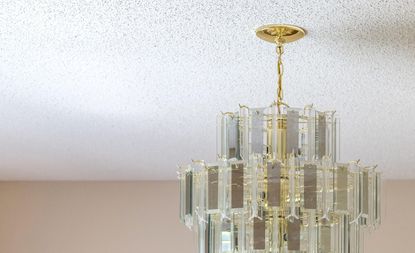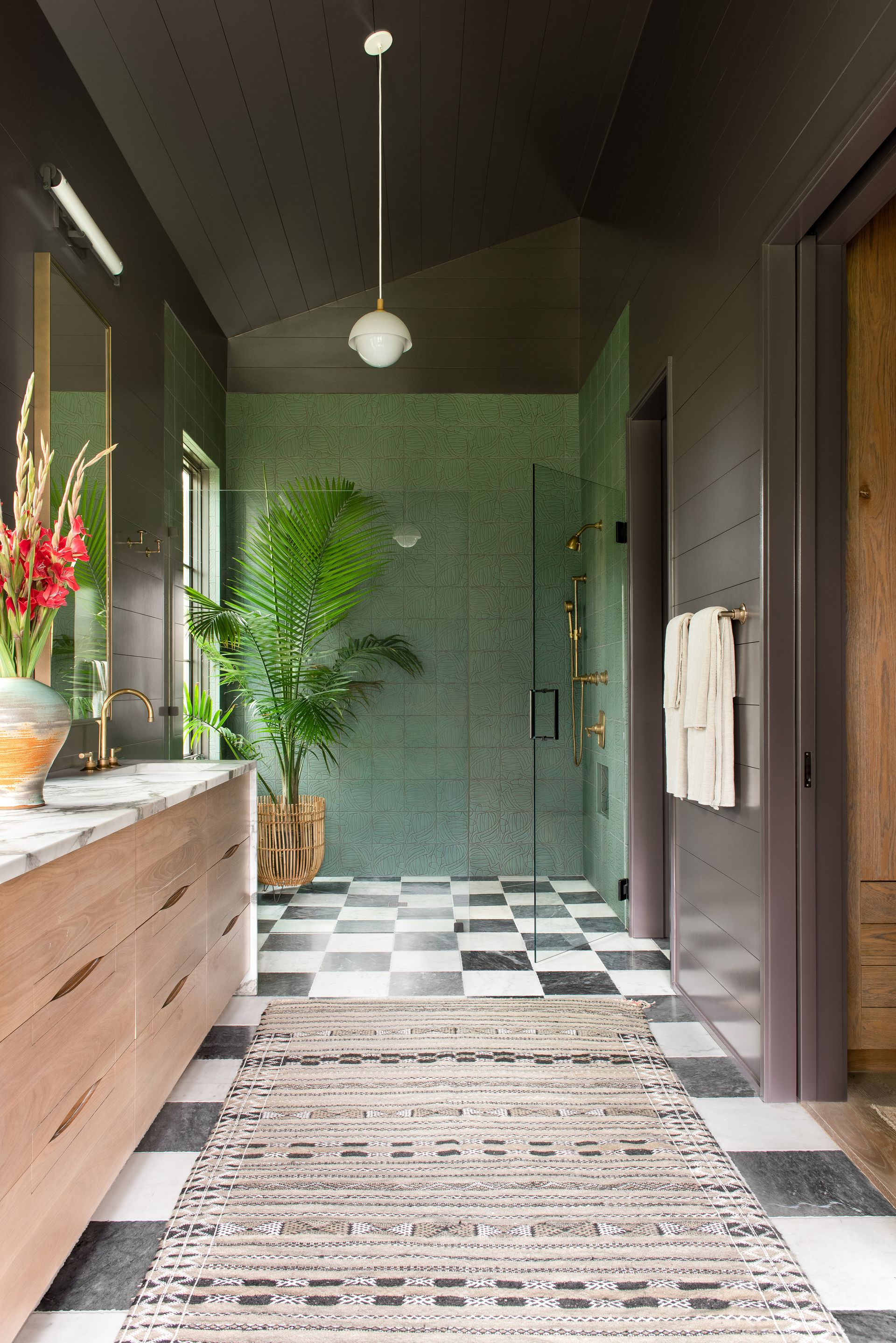This hack for getting rid of popcorn ceilings changes everything - fast, cheap and effective
Getting rid of popcorn ceilings on your own is tricky, but you can easily disguise one with some simple DIY. These experts explain how


When it comes to 1970s decor, there are a few remnants that have made their mark on our style today. Some of those - teak furniture, geometric patterns, rattan accents - have come full circle. Others have been harder to erase, despite the fact we'd probably rather never lay eyes on them again - we're talking avocado bathrooms, shag carpets, and of course, popcorn ceilings.
Otherwise known as stipple ceilings, popcorn ceilings are distinguished by their bumpy textured surface which is created by tiny particles of vermiculite or polystyrene. They were a popular choice for decorating ceilings in the mid-century for their time-effective and cost-efficient application, plus their ability to mask any cosmetic flaws in ceiling foundations. Now, however, they've fallen well and truly out of fashion.
If you want to get rid of your popcorn ceiling, I have both good and bad news. The bad news? Removing it is tricky, and it's highly recommended you hire a professional to do so, which can be costly. The more positive news is, you can easily disguise one with some simple DIY. We spoke with some decorators and designers to find out how.

Lilith is an expert at following news and trends across the world of interior design. She regularly shares stories with readers to help them keep up-to-date with ever-changing trends with DIY tips on how to stay current. For this article, she spoke with decorators and designers to learn how to disguise those outdated popcorn ceilings.
Why are popcorn ceilings no longer popular?
As far as living room ceiling ideas go, popcorn ceilings had a good run. Throughout most of the twentieth century, they were one of the most popular choices for decorating the fifth wall, but the sight of them now instantly dates a space.
'Trends come and go, and popcorn ceilings have been decreasing in popularity ever since their peak in the 80s,' explains Mallory Micetich, a home decorating expert at Angi. 'Most people opt for smooth-textured ceilings now to give their homes a modern feel.'
How do you remove popcorn ceilings?
Unless you're a trained decorator, removing popcorn ceilings won't be easy. Not only is the task a difficult one but it comes with some serious health risks. This is because popcorn ceilings in homes built before the 1970s will likely contain asbestos.
'Before you remove popcorn ceilings, you need to test your ceilings for asbestos,' says Mallory. 'I recommend bringing in a pro to test your ceilings, but you can also do it yourself with a DIY testing kit. If the test comes back positive, you’ll need to bring in a professional removal team if you're still determined to get rid of your popcorn ceilings.'
If the test comes back negative, it's safe to remove it on your own, but that isn't to say it will be an easy job. 'The DIY approach involves spraying the ceiling with water, scraping off the texture with a wide putty knife or a specialized ceiling scraper, and then sanding and painting the ceiling,' says Brian Jeffries, Lead Advisor of Building Product Advisor. When spraying the water, use enough to soften the texture but avoid using so much that you weaken the drywall underneath.
Unfortunately, if someone has painted a popcorn ceiling in the past, it won’t easily absorb the water making it much harden to soften the texture. In this case, you may want to consider your best bet is calling in some professionals or going disguising your ceiling instead.
What's the alternative to removing it?

Sound like too much work? We think so too. Luckily though, there is an alternative solution. If you want a quick, easy, and budget-friendly fix for a popcorn ceiling, rather than looking for ways to remove it, experts encourage you to disguise it instead.
'You can easily cover popcorn ceilings with drywall to create a new, smooth ceiling over the original popcorn ceiling,' says Mallory. Hanging drywall to a ceiling simply involves measuring the board and screwing it into your ceiling studs, and can easily be done by novices, but you'll probably need an assistant on hand. 'You can expect to pay between $160 and $200 for materials to cover the ceiling in a 12x12 foot room. If you hire a pro for the project, you’ll need to budget for labor costs as well,' adds Mallory.
Once you've installed your drywall and hidden that bubbly-looking ceiling once and for all, you can now consider painting or decorating your smooth fifth wall. The easiest option is to go for a painted ceiling, but if you want to be a bit more experimental, Brian has a few ideas. 'Some popular contemporary methods for decorating ceilings include tray ceilings, coffered ceilings, and wood paneling,' he explains. 'If you want to stick to painting your ceiling, applying a metallic finish can create a modern and luxurious look.'
Of these options, the most simple DIY approach is wood paneling. You can easily create the look of a shiplap ceiling using slatwall panels, a lightweight material made of medium-density fiberboard that can be added to your ceiling and built to fill your space. 'Not only is it relatively easy to do, but adding wood paneling to a ceiling can help to create a warm and inviting atmosphere,' says Brian. It's also the perfect way to tap into the organic modern trend if you're ready for a more up-to-date ceiling style!

For a neutral and natural look in your space, these slatwall display panels from Amazon are the way to go. These light-weight are super simple to install and suitable for the ceiling.

This multipurpose stainless steel taping knife from Amazon is perfect for removing popcorn ceilings. The carbon steel blade- is also coated with corrosion resistance for promised durability.
Be The First To Know
The Livingetc newsletter is your shortcut to the now and the next in home design. Subscribe today to receive a stunning free 200-page book of the best homes from around the world.

Lilith Hudson is the News Editor at Livingetc, and an expert at decoding trends and reporting on them as they happen. Writing news, features, and explainers for our digital platform, she's the go-to person for all the latest micro-trends, interior hacks, and color inspiration you need in your home. Lilith discovered a love for lifestyle journalism during her BA in English and Philosophy at the University of Nottingham where she spent more time writing for her student magazine than she did studying. After graduating, she decided to take things a step further and now holds an MA in Magazine Journalism from City, University of London, with previous experience at the Saturday Times Magazine, Evening Standard, DJ Mag, and The Simple Things Magazine. At weekends you'll find her renovating a tiny one-up, one-down annex next to her Dad's holiday cottage in the Derbyshire dales where she applies all the latest design ideas she's picked up through the week.
-
 These 12 Best Table Lamps for Your Desk — Perfect Glows for a Creative Home Office
These 12 Best Table Lamps for Your Desk — Perfect Glows for a Creative Home OfficeThe best table lamps for your desk is have a soft, targeted glow. Elevate your WFH set-up with these stylish picks endorsed by Style Editor Brigid Kennedy
By Brigid Kennedy Published
-
 The Nespresso VertuoPlus is 30% Off for President's Day, and it's Kim Kardashian's Coffee Maker of Choice
The Nespresso VertuoPlus is 30% Off for President's Day, and it's Kim Kardashian's Coffee Maker of ChoiceThis sleek and stylish coffee maker was spotted in Kim's home bar, and you can currently save $60 if you buy yours from Amazon
By Lilith Hudson Published

